Adding some greenery to your office space is never a bad idea. Not only can some office gardening improve the overall look and feel of your office, but it’s actually been shown to improve productivity all around.
Now, when it comes to the best office plants in Australia, there is a range of incredible options for you to choose from. Follow our guide to discover all the office plant benefits and how to care for your favourite picks.
More...
Benefits of Office Plants
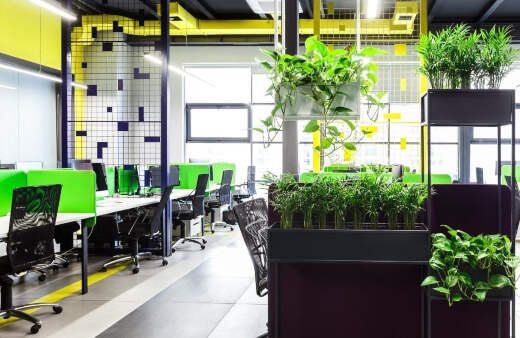
As humans, we have a deep need to feel connected to nature. It’s why many of us choose to grow beautiful, luscious gardens and cultivate indoor plants in our homes.
However, when you’re working a 9 to 5, cooped up in an office desk it can be hard to feel connected to any kind of nature. Of course, the same applies to those working from home.
Luckily, introducing some office plants are a great way to bring the feeling of nature into your every day – while offering a range of other benefits.
So, how can some office gardening help you in your work environment? Here are a few of the top benefits.
Plants Improve Air Quality
There’s nothing worse than a stuffy office, so plants provide a great way to clean office air and improve oxygen flow – in turn, reducing fatigue. Certain plants can even remove harmful chemicals like benzene and formaldehyde from the air.
Plants Increase Productivity
While it wouldn’t be your first connection to make, adding some plants to your office can actually improve office productivity. A range of studies has shown that employees are far happier, more engaged and productive when they work in a psychologically stimulating environment.
Plants for Offices Reduce Noise
Plants have a great quality of absorbing sound. This way, using a range of smaller and taller plants, you can help to reduce distracting or annoying office sounds.
Office Plants Can Help Reduce Stress

Studies have shown that plants, and more importantly evergreen plants can have a calming and relaxing effect. In fact, studies by the University of Technology in Sydney have found that even just one pot plant can lift staff spirit and promote overall well-being.


Get Your Free Guide:
Master Growing Australian Natives eBook
A Must Have Complete Guide for Every Australian Garden
Get Your Free Guide:
Master Growing Australian Natives eBook
A Must Have Complete Guide for Every Australian Garden
More so, environments, where plants were introduced, recorded a 47% reduction in tension and anxiety.
Office Plants Inspire Creativity
Do you know how writers escape to the country to write? It’s because natural elements tend to improve concentration and fuel creativity.
A 2015 report found that offices with natural elements had almost a 15% higher rate of creativity. So, now that you know all the reasons why you should look at adding a few plants for the office, it’s time to consider which plants.
Before going to your local nursery and picking out any plants, it’s essential to note that you need a plant that will thrive in an indoor space.
Luckily, a range of plants and Aussie natives are perfectly adapted for lower light, stagnant air spaces.
20 Best Office Plants in Australia
There is a range of desk and cubicle friendly plants that you can consider, many of which are gorgeously evergreen, some of which even bloom. Here are a few of our top picks:
1. Philodendrons
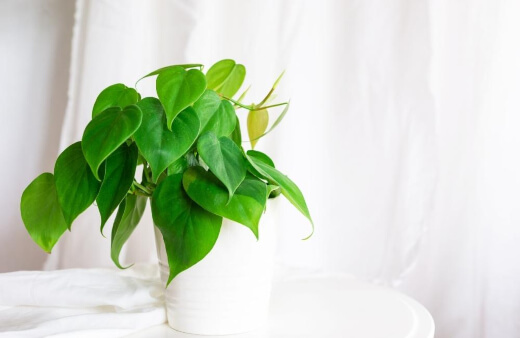
Philodendrons are popular indoor plants, prized for their large leaves and absolute tolerance for lower light levels. While they are tropical plants that thrive in warm environments, they seem to grow pretty steadily in temperature-controlled offices.
These plants are largely hassle-free, needing watering or misting once a week and fertilising every now and then. They’re not plants that need much pruning and only need to be repotted.
For a real striking choice, consider growing the Philodendron ‘Brasil’ or Philodendron xanadu.
2. Bromeliads
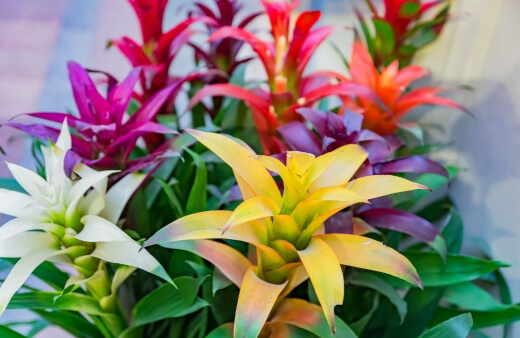
Bromeliads are always a stunning choice. They come in a range of shapes, sizes and colours, making them perfect for the desktop. Although they are usually grown outdoors, they enjoy plenty of warmth and humidity.
These plants don’t need much watering and prefer loose, well-draining soil. Which means they’re not a super picky plant. However, they do require a decent amount of airflow so consider keeping them near an open window from time to time.
Here is everything you need to know to grow and care for bromeliads.
3. Anthuriums
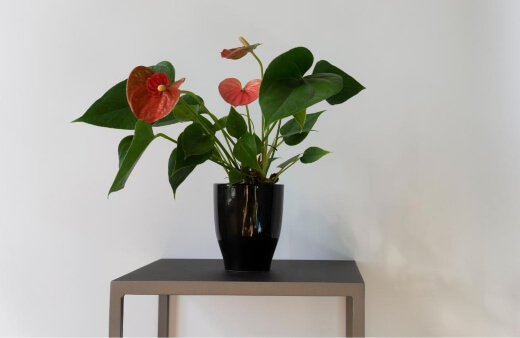
If a flowering plant is what you’re after, anthuriums are a perfect choice. With broad waxy leaves and large flowers which come in a range of colours, they’re a great way to stimulate some creativity.
These plants definitely have some bright indirect light so be sure to pop them in the right spot. Fill your pot with some loose draining soil and water only when dry to the touch.
4. Peace Lily
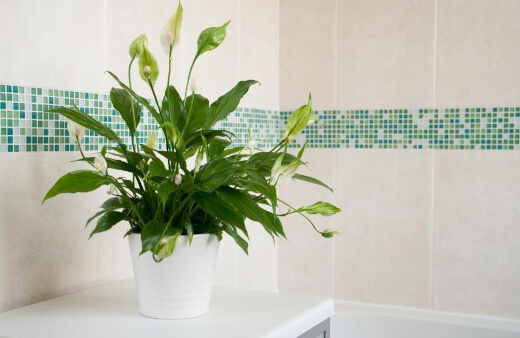
There is a reason that peace lilies are featured in almost every indoor plant guide. These incredible plants are utterly stunning, evergreen with gentle white blooms that appear almost throughout the year.
Peace lilies don’t need any direct sunlight, so a semi-shaded spot is ideal. They will require a good level of moisture so be sure to keep a mister on your desk and support your plant with a gentle mist in between meetings.
5. Zanzibar Gem

There’s nothing better than an office plant that can take a little bit of neglect. Zanzibar gem is a taller growing, evergreen plant that will thrive next to your desk.
These plants thrive with irregular watering and are happy with even just a little bit of indirect light. Be more equipped to grow and care for this plant with our Zanzibar gem grow and care guide.
6. Sansevieria Moonshine
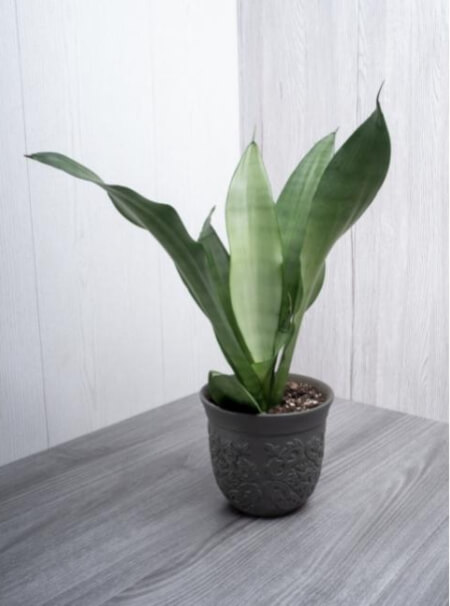
The sansevieria moonshine is a quirky indoor plant that you often see grown in offices with strong, upright leaves. These long-lasting plants thrive in a warm, dry environment and can also handle a little bit of neglect.
Sansevieria moonshine should be treated as most succulents. Give them loose, well-draining soil and water infrequently to avoid root rot.
7. Fiddle Leaf Fig

Another great choice for a taller growing plant is the fiddle leaf. These plants have a long stem and incredibly large, glossy leaves. These plants are definitely on-trend and will only need a little bit of attention.
Keep your fiddle leaf in an area with bright, unfiltered light. You’ll need to ensure a rich potting mix and a good amount of moisture throughout the growing season.
8. Yucca Plants
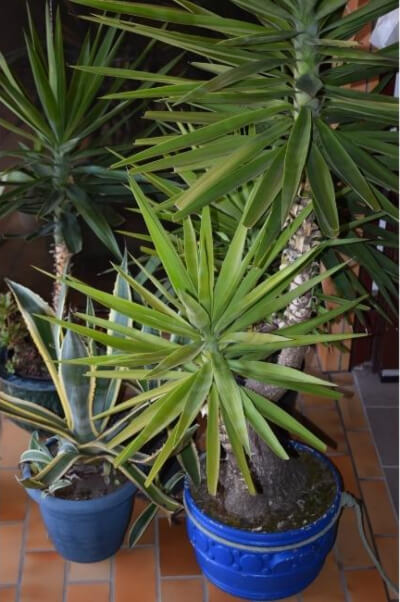
If you’re looking for something a little more exotic, then there’s no better choice than Yucca plants. These are fuss-free, easy-care plants with exciting foliage.
Be sure to pick the right potting medium when it comes to these plants. You won’t need to worry about getting anything expensive, these plants are happy in low quality or cactus mix soils.
9. String of Pearls
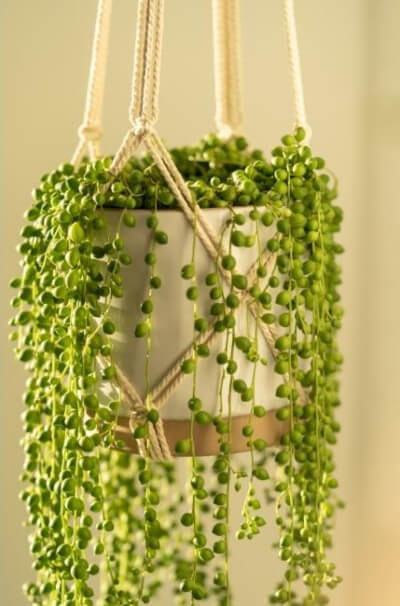
Got an office with lots of shelves? Consider adding a string of pearls to the mix. This curious, cascading plant is perfectly photogenic, but can sometimes be tricky to keep alive.
With a string of pearls, it’s important to pick a moist, yet well-draining potting medium. Resist over-watering these plants and be sure to pick a pot with plenty of watering holes so the soil can drain adequately.
Get to know more about this succulent by reading our in-depth string of pearls growing guide.
10. Devil’s Ivy
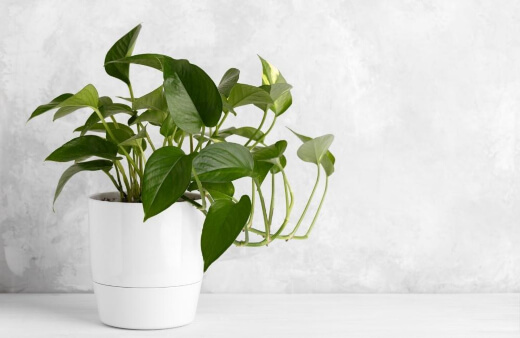
Another great choice on the shelf is the beautifully trailing Devil’s Ivy. It’s an ideal choice for those who don’t have the greenest thumb for office gardening. It won’t matter where you plant it, how little light it gets, you’ll have a thriving plant as long as you keep it well watered.
Keep an eye on your soil and be sure to water it regularly. Plus, once it starts thriving you can propagate plenty of smaller plants. Refer to our devil's ivy growing guide for more info on how to grow this amazing houseplant.
11. Tillandsias
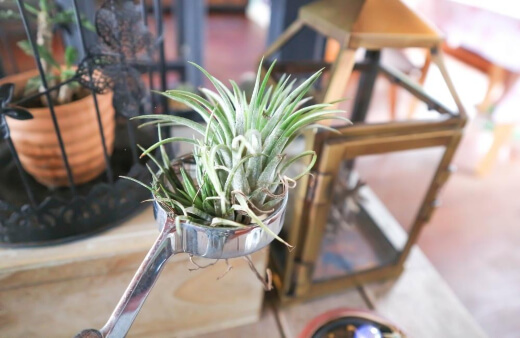
Let’s talk spikey stunners, Tillandsia is a gorgeous house plant that thrives in unforgiving deserts. So, as long as you protect it from frosts and cold drafts, you’ll have thriving, long-living plants.
In winter, you can almost forget about these plants entirely and in winter, only need an occasional spritz from time to time.
12. Calatheas

Calatheas, also known as Prayer plants are an incredible genus of plants considered to be one of the best office plants. They have differently patterned leaves, some with a dark ruby underside.
They thrive out of the sunshine, while still needing some indirect light. During the summer, you’ll want to make sure your plants stay well moist. Consider keeping a mister on your desktop for this one.
Here is an in depth guide on how to grow and care for calatheas.
13. Spider Plant

Don’t let the stringy foliage put you off, spider plants are perfect desk companions. They’ve got long, narrow leaves with white stripes that offer a lot of appeals.
You’ll want to pick a rich potting mix and will need a rich potting mix. Get to know all the details about easy-to-grow plant in our spider plant how to grow and care guide.
14. Aloe Vera
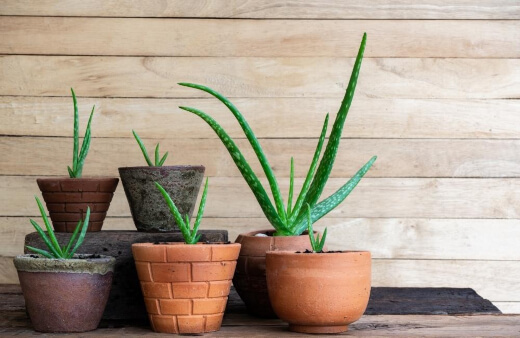
Succulents are a great choice for those not gifted with a green thumb. Aloe needs little attention and thrives in warm and dry environments. Be sure to pick a potting medium suited to succulents and avoid overwatering at all costs.
15. Aglaonemas
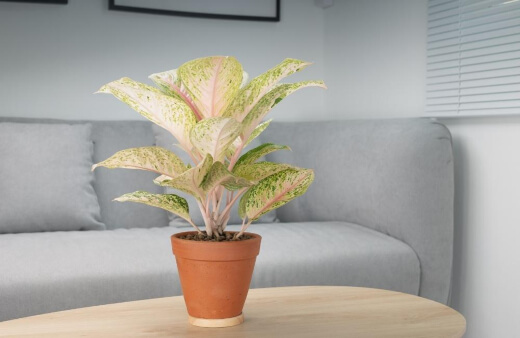
Aglos, also called Chinese evergreens, have fantastic deep green leaves, some with a gentle sliver of silver or red. Believed to bring long life, these gorgeous plants.
These plants prefer a peat-based potting mixture and a moderate watering schedule.
Find out more about Aglaonema and its popular varieties here.
16. Lucky Bamboo
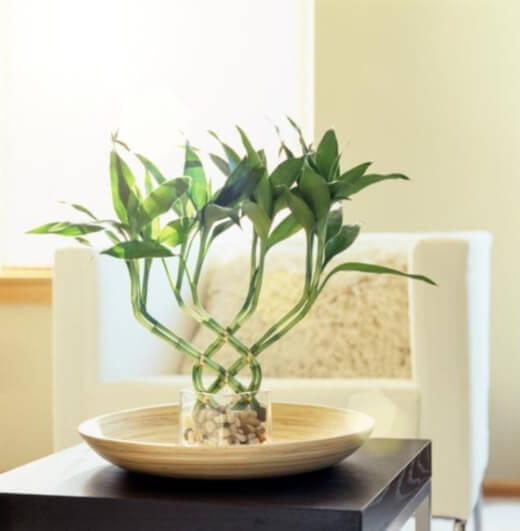
While most of us associate bamboo with a tall and towering plant, there is a range of varieties that are the perfect fit for a desktop, like Dracaena sanderiana commonly known as lucky bamboo. These plants are great for Feng Shui and thrive in dappled light.
Just be sure to give your bamboo sufficient clean water, and the right kind of container to grow in. In addition to this plant, another Dracaena variety you might want to look into is the Dracaena fragrans ‘Massangeana’ or commonly known as the Happy plant which is also perfect for growing indoors.
17. Ficus
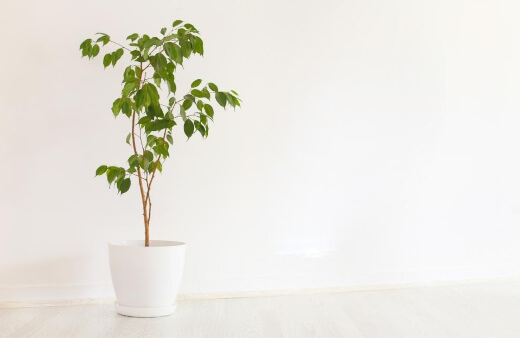
If you’ve got a corner office that gets a good amount of natural light, then the ficus is an ideal choice. Whether you choose to keep it small or let it grow large, you’ll have a stunning little office companion.
These plants prefer dry soil, so can be left to dry out for a few days.
18. Rex Begonia
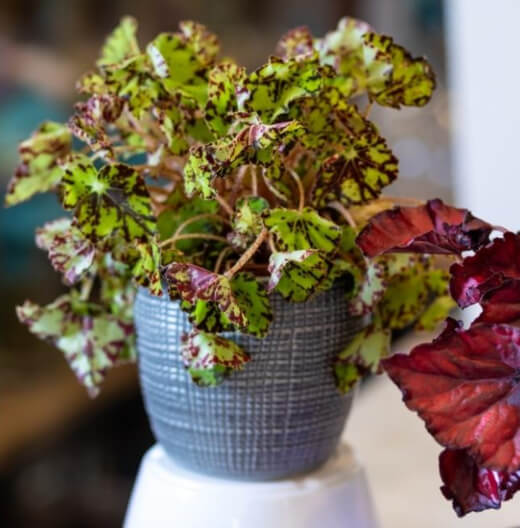
Begonias are a great option if you’re looking for something a little different and exciting. Of course, the more light they get, the more vivid the colour, but they’re perfectly happy not getting any direct sun.
You will need to make sure your plants get the moisture they need, so regular watering and misting is a must. Interested in begonias? Head out to our ultimate Begonia growing and care guide where we tackled it's different types and how to grow each one.
19. Succulents
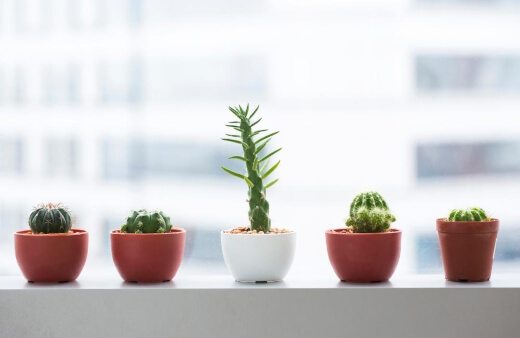
Who doesn’t love a good succulent? There are so many succulent varieties to choose from, from fuzzy to spikey, from tinged to a deep green. Plus, they’re a great choice to create a little desktop terrarium for you to enjoy.
Of course, it’s essential to pick a succulent potting mix and avoid overwatering at all costs.
20. Cacti

Coming a close second to succulents, are cacti. These are the ideal option if you want a touch of something small, without having to worry about care. Succulents almost completely take care of themselves.
Water them every now and then, or don’t. Your cacti collection is bound to thrive in an office environment. Check out some of our cactus growing guides below:
Caring for Office Plants
Now that you’ve chosen the best office plant for you, it’s important to take care of it properly so you don’t suddenly have a sad, drab and dying plant on your desk.
Of course, every plant has its own needs when it comes to light, moisture and maintenance but there are a few common rules of thumb you can keep in mind.

Watering
Take special care when it comes to watering. Indoor plants definitely need the right balance to avoid issues like root rot. Watering is often the most common cause of office gardening failure. In general, allow your plants to drain properly and avoid letting your plants sit in water at any time.
Keeping a saucer under your plants is perfect, it’ll let you see if there’s too much water and protect your desk from nasty water stains.
Lighting
Certain plants get by with almost no light. Whereas others need at least a little bit of indirect light to thrive. Depending on which plant you choose, keep your plant near a window if you can. If all else fails, fluorescent light is almost just as good.
Pruning
Pruning isn’t always a problem with these plants, but for some removing, spent flowers and leggy growth will encourage prosperous growth in the future.
Don’t be afraid to grab those office scissors and snip where you see fit. Be sure to sterilise your scissors first to avoid infecting your plants. Or better yet, get a good set of secateurs for that garden feeling cut.
Office Plants Frequently Asked Questions
What plant is best for an office?
It’s impossible to say what plant is best for every office because light levels, watering routines, and temperature will be different in every office, but in terms of choosing an easy-to-care-for plant that will put up with a combination of neglect and obsession, something really simple like English Ivy brings a calming effect to any office and can cope with most conditions.
Which plant is lucky for an office desk?
Lucky bamboos are traditional office desk plants, thought to bring wealth and fortune to their keepers. They are easy to care for, and even if none of the mystical properties turn out to be true, it’s always calming to have the presence of fresh green foliage on any desk.
Is it good to have plants in the office?
Office plants have been proven to boost productivity, whether it’s as a result of easing anxiety and making workers feel more in touch with nature, or as a focus or distraction which demands attention and a break from work.
Plants help us to destress and unwind, no matter how detached we may feel from them, so growing indoor plants in an office is a great cost-effective way to boost productivity.
What plants grow well in offices with no windows?
There are no land plants on earth that will grow with no light, but there are some deep sea plants that have learned to adapt to very low light levels.
For extremely low light, or offices with LED lighting, it’s possible to grow snake plants, ZZ plants, and Cast Iron Plants but they will need watering less frequently, and only when the surface soil is beginning to dry out.
What plants will survive in offices with low light?
In low-light offices, dracaena, bamboo palms, and parlour palms can grow well, and add a bushy, forest vibe to any office space. They are easy to look after too, so if you forget to water them, or three people water them in one day, they will recover, and they will forgive you.
How do office plants survive without sunlight?
Office plants like parlour palms are adapted to low-light environments in the wild, and most forest floor plants do not need much sunlight to successfully produce the chlorophyll (sugars) they need for growth.
Broad-leaved, or densely foliated plants are better adapted to these low light conditions as they have a greater surface area to maximise sunlight capture.
Why do people put plants on their office desks?
Office plants boost productivity and improve your mood, but even if you’re not keen on clutter, there are some compact office plants that help to clean the air too, and will make you more comfortable in your space.
So, there are tons of reasons that people grow plants on their office desks.
What is the most low-maintenance plant for an office?
Aloe Vera is great for bright offices and requires very little care or attention. The succulent leaves store water, so even if you completely forget about it, it will survive for several weeks, even months, without watering.
How do you keep office plants alive?
Keeping office plants alive is tricky, not because people can’t do it, but because you need to coordinate your efforts. The most common cause of office plant deaths is smothering; when too many people take care of a plant at once.
Indoor plants hate being overwatered and it can cause their roots to rot, so make a schedule and tick off when you’ve done the rounds, so someone else doesn’t repeat the process.
Can plants grow in LED lights?
You can get ceiling bulbs that produce UV wavelengths, and mimic the light of sunlight for offices with low light. Plants can be grown in complete darkness without any natural light with just Led lights if your office has no windows tall.
Why are my office plants dying?
Offices can be busy places, full of people breathing out carbon dioxide, and increasing the humidity and temperature of their work space. Plants in overly humid spaces can suffer fungal problems, so keep your office well-ventilated if you notice signs of yellowing leaves or spots on your plants.
What plants help to reduce anxiety in the office?
Don’t stick to houseplants in your office. Some plants, like lavender, can grow happily in pots indoors with good lighting and good drainage, and help to reduce office anxiety and work-related stress.
Similarly, lemon balm and members of the mint family are a great scented distraction from the hustle and bustle of the office.
For more compilation of different plant types, refer to our list below:
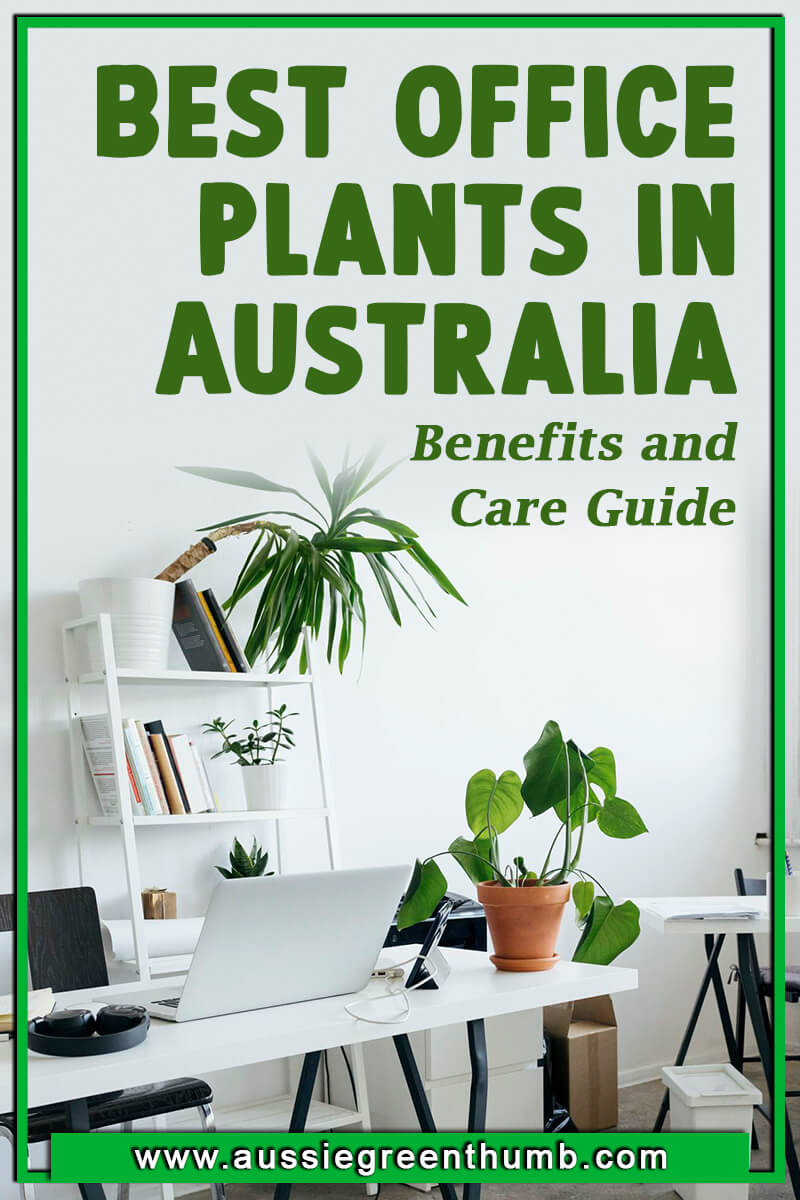
Get Ready for Some Office Gardening!
So, there you have it, the perfect selection of plants to turn your office into a beautiful, naturally inspired space, helping you focus, relax and breathe better. Pick a plant from our list of the best office plants in Australia and get planting!
Published on January 14, 2023 by Nathan Schwartz
Last Updated on October 1, 2025




